Timex
Expedition WS4
Wide
Screen 4 Function Watch
Test
Series by Jennifer Koles
March
31, 2010
|
Skip to my Initial
Report- November 21, 2009
Skip to my Field
Report- February 11, 2010
Skip to my Long Term
Report- March 31, 2010
Personal
Information
Name: Jennifer
Koles
Age: 35
Gender: Female
Height: 5 ft 5 in (1.65 m)
Weight: 140 lb (64 kg)
Email address: jennksnowy at yahoo dot com
City, State, and Country: Orange County, California,
United States
Backpacking Background
After
getting into the outdoors scene camping while 4-wheeling
and day-hiking, I switched to backpacking in the early 2000's. I have backpacked
extensively in Utah, Wyoming and Idaho along with California, Pennsylvania
and Nevada. I have slowly been cutting my base weight to be able
to go longer in duration and distance. I have done
so mainly by using better gear and dumping heavy luxuries. I backpack year
round in all weather, and usually take a free standing tent
and a gas stove on all my trips. I love trying out new gear.
|
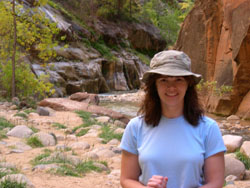
The author in the Narrows at Zion
National Park, Utah.
|
Initial
Report
November
21,
2009 |
Product
Information and Description
Product: Timex
Expedition WS4 Wide Screen 4 Function Watch
Manufacturer: Timex
Year of Manufacture: 2009
Manufacturer Website: www.TimexExpedition.com
Listed Weight: None
Measured Actual Weight: 2.95 oz (84 g)
Listed Case
Width: 50
mm (1.97 in)
Case Width Actual Measurements: 48 mm
(1.89 in)
Watch Lens
Actual Dimensions: 38 mm x 25 mm (1.50
in x 0.98 in) measured at the widest point
Available Colors: White,
Orange, Blue, Yellow, Black/Orange. Black/Gray
Color Tested: Black/Gray
MSRP: $200.00 US
Warranty: 1 year limited warranty
(U.S. only) |
|
The Expedition WS4 came packed
in a box that noted to be designed and produced to reduce
environmental impact. It came with a 147 page user manual
(in English, French and Spanish) that is small enough to
fit in my pocket and a pocket guide that is larger than the
user's manual. Hum. The WS4 has an oversized wide screen
rectangular shape display versus a circular display found
with many of the watches on the retail market. And boy is
it ever oversized! The large face follows the shape of my
arm due to the rectangular shape. It is easy for me to read
the display since it is so large and the text is in a large
font. I can even read it without my glasses on. The acrylic
lens has orange markings on it for the clock; a squared off
area for the time and the main function displayed; and the
words altimeter, barometer, thermometer and compass in letters
I can barely read on the left side of the face. On the steel
top plate of the watch is the word "TIMEX" on the
bottom and a logo for the expedition series on the top just
above the lens. The watch case is made of a durable and lightweight
resin.
The band is 1.25 in (3.17 cm)
wide and is made of resin. It has the words expedition embossed
on it along the side of the buckle type fastener. Expedition
is also embossed on the strap holder slide. The fastener
is a traditional buckle type, which is metal. The strap is
held on with four screws and it can be removed and replaced
with a fabric type of strap if I wish.
The case of the watch has three
buttons on the right side. One round button in the center
is for the INDIGLO night-light feature. The other buttons
are rectangular shaped and are "start/split" and "stop/reset".
There are two rectangular buttons on the left side are "set"
and "mode".
Main Features of the Expedition
WS4:
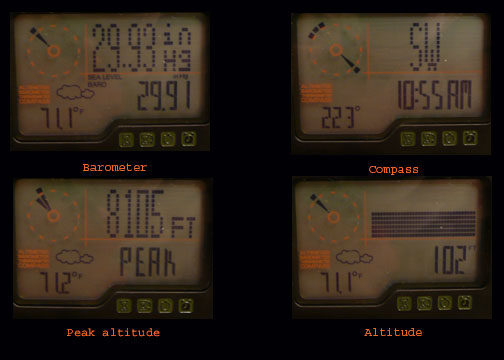
- Altimeter- displayed in meters or feet;
tracks current, peak, and accumulated altitude; graph
display over 36 hours
- Barometer- tracks sea level pressure
changes in a graph over 36 hours; tracks high, low, and
current pressure
- Compass (digital headings and
digital needle with adjustable compass declination angle)
- Thermometer
(displayed in Fahrenheit or Celsius)
- Weather conditions
- Time and date function (two times zones
can be set) also has a 12 hr or 24 hr time setting
- Date display in MM-DD or DD.MM formats
- Both a digital and analog clock
- Hourly
chime and button beep are optional settings
- Daily alarm
(has daily, weekday, weekend settings and a 5 minute
backup alert)
- Water resistant to 50 m (164 ft) if
one of the buttons is pressed underwater it compromises
its waterproof properties
- Screw down battery (CR2430)
- 100 hour chronograph with lap and split
times
- 24 hour countdown timer
- INDIGLO night-light with NIGHT-MODE
feature
- Target altitude setting and altitude
alarm
- Activity review (captures lows, highs,
and adventure averages)
Initial Impressions
So far I am pleased with the Expedition WS4. It was
easy to set up, I can actually read what is on the
face, and it appears to be durable. It is on the heavy
and large side as compared to my daily watches. But,
this is no daily watch. It has been many years since
I owned a multi-function watch, and it did not have
all these features. So I guess I can expect it to be
large any heavy.
I was able to set the watch up and use some of the
functionality in just a few minutes. Some of the functions
I was able to use and set up without reading the directions.
I guess I am like a man in that respect. The watch
fits on my arm well and I have yet to wear it for any
length of time. So far I like the rectangular shape
because it follows the contour of my arm.
I looked at the manufacture's website prior to receiving
the product. And there were no surprises except for
the size. It looked large on the website, but actually
having something in my hands is no comparison to a
web page. The features of the WS4 are listed on the
website and a user friendly interface shows the key
functions of the watch. The user manual, pocket guide,
and how to cards can be downloaded. There is also
a FAQ and testimonials. Conrad Anker (my favorite mountaineer)
is testing this watch too. Cool!
|
Field
Report
February
11, 2010 |
Testing Locations
Mt.
Woodson, California: The
watch was hung on my pack strap while
rock climbing and included day-hiking, mild bushwhacking
and belaying.
Mt. San Jacinto State Park,
California: This
was a backpacking trip with clear skies and sunshine.
The high elevation was 9,000
ft (2,750 m). The low temperature was 17 F (-8 C). The
watch was worn here over a quilt type of jacket/shell
or a wool long-sleeve base layer.
Bommer Canyon, California: The
watch was worn over a wool long-sleeve base layer for
a full moon night hike with clear skies. We hiked 3 miles
(5 km). The temperature was in the low 50's F (11 C).
Cleveland National Forest, Fullerton
and Whiting Ranch California: The watch was
worn here while mountain biking on several occasions
over arm warmers or on bare skin. The temperatures
were in the 50's F (12 C) to the low 60's (16 C).
|
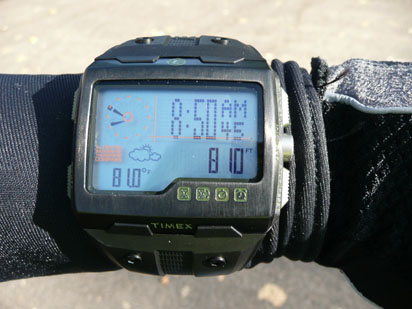
Worn over arm warmers |
Performance in the
Field
So far the Timex WS4 is performing
well in the field. I must say that the large face of the
watch can be easily read in the day or night (using the
light feature) while worn on my arm or on my pack strap.
The standard sized strap fits me on my bare skin, over
my arm warmers, over my wool base layers, over my shell,
or over my quilt type jacket.
I like the idea of being able to track my activity highest/lowest
and average altitude and temperature plus ascent, decent,
my time above my base setting and the temperature ranges.
Even though this feature tracks the barometric pressure
range, I did not use those statistics for any data collection.
This features has both text and graph views. I liked
the graph view feature of the altimeter and the temperature
range, the barometer graph is shown, but here again I
did not use this data. This feature enabled me to have
a quick glance at my statistics and made me feel good
about my activity progress. I have to remember to use this
feature I must start the chronograph or this data is
not recorded. On a few uses I forgot to start the chronograph
when I started my activity. When using this feature it
is nice to see when ascending or descending how much
elevation I gained or gave back. This information is
not easily understood when just viewing the altimeter
fields on the watch.
|
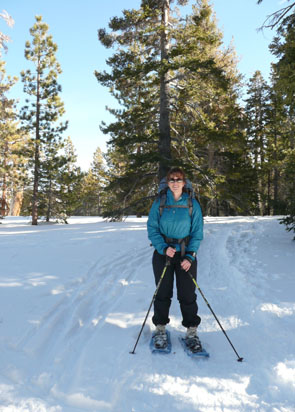
Timex WS4 worn over a quilt
type of jacket |
While mountain biking at night and at base
camp I found the INDIGLO night feature handy that I could press
any button and the screen would like up for a few seconds.
The INDIGLO light is a blue/green color that is not overly
bright or harsh on the eyes. All the information on the screen
can be easily read using the light. The night feature only
lasts 7 to 8 hours and when stuck in a tent for 11 hours I
forgot to reset it. However, I just pressed the INDIGLO button.
I used the timer of the watch for timing
pouched food cooking times. I also used it randomly to time
non-eventful activities (like if something was going to start
in 10 minutes or turn around time). I was able to hear the
chime with no difficulty. It is faint but I was alert so I
could hear it. The standard timer setting has 8 sets of chimes
and then it stopped. I also set the timer up on repeat so
that it repeats the timer and chimes 8 times until STOP is
pressed. I would like to see the timer function that it also
chimes without repeating the timer until STOP is pressed.
Now for the alarm. While backpacking I had
the watch in my sleeping bag because while not wearing the
watch, the screen display was fading and the refresh between
the screens was slow in the cold temperatures, around 25 F
(-4 C). When I had the watch on my arm the screen was no longer
fading and the performance was improved. It got down to 17
F (-8 C) outside and I am unsure of the actual temperature
inside the tent. I did not want to wear the watch while sleeping
due to the large face and possibly poking myself in my eyes.
I set the alarm for Monday at 6 a.m. and I never heard it.
There is supposed to be a backup alarm in 5 minutes, but I
did not hear that either. I set the alarm for one time at 7
a.m. and I heard that alarm. I may not have heard the first
alarm because I was in a deep sleep, the watch was in my sleeping
bag, or the chime was faint. I am the type of person that needs
two alarms blaring to wake up.
I used the altimeter setting to set a base
location, and a known elevation (used for calibration on the
trip). The altitude alarm gives a chime and a
screen display when the targeted altitude is reached. I used
this to set the peak point on a mountain biking trail. The
altitude does change slightly overnight and this is typical
of altimeters when there is a change of barometric pressure.
I found it helpful to set an altitude reference point for camp
so the altitude can be calibrated easily. It took me a few
tries to get this working correctly in the field because I
did not have the reference manual with me. This set up is not
as intuitive as the basic watch setting. But, Timex provided
a pocket guide with the directions that I should have carried
with me. At least the first time.
I did not find the 36 hour display of the
altitude very helpful. I used the activity review instead.
The 36 hour graph was spanned over such a long period of
time that it did not appear that I made significant gains during
activities that were short in duration.
I found the temperature reading to be accurate
when the watch was not worn on my wrist or in direct sunlight.
The temperature increased from 10 to 25 degrees
when worn on my wrist. This can be expected. It took about
15 minutes for the watch to read the correct temperature when
it was removed from my arm and placed in the shade.
At times the weather function was not accurate.
This is based off the barometric pressure. I did not need to
rely on this data on my backpacking trip. I just laughed saying
"It is going to rain".
I am happy with the functions of the Timex
WS4. I just wish it was slightly smaller. If I do not need
a GPS on trips this watch suits all my needs. I have yet to
change the battery even since it has been exposed to temperatures
below freezing.
Long
Term Report
March
31,
2010 |
Testing Locations
Mt. San Jacinto State Park, California: This
was a snowshoeing day trip with windy conditions. The
high elevation was 9,400 ft (2,865 m). The high temperature
was around 48 F (9 C). The watch was worn here over a quilt
type of jacket/shell.
Orchard Hills, California :This
was a night hike on Irvine Ranch Conservancy Land. The low
temperature was in the 50's F (15 C). The watch was worn
here over my quilt jacket.
Whiting Ranch, California: The
watch was worn here on a two day hikes. The temperatures
were in the 60's F (16 C).
Peters Canyon, California:The
watch was worn here after work for two day hikes. The temperatures
were in the low 70's F (21 C).
St. George, Utah: The watch
was worn after mountain biking. The high temperature was in
the high 50's F (15 C).
Performance in the
Field
So, far the Timex WS4's
general features are working well. I am having some
issues with the compass and the altitude setting. I
sometimes still forget to start or stop the chronograph.
Hence, my data review is skewed at times. But, this is
user error.
I have compared
the altitude with known elevation and with maps. And
I found that it is more accurate when I use the altitude
settings for the base and add the additional known altitude
settings. I reset the altimeter each time I use the watch,
so it is more accurate. I can expect some discrepancy
in altitude because this functions off the barometric
pressure. For instance at the base of the Palm Springs
Tram I set the altimeter to a known elevation and at
the top of the tram the watch was off by over 300 ft
(91 m). The tram does travel at a higher rate of speed
than me walking and I expected this due to this type
of altimeter. When hiking the altimeter is off by about
100 ft (30 m).
The
battery is still running strong and I have not encountered
any major technical issues with the watch. I still think
the size of the watch face is overkill. If some of the
features on the left side of the face were removed, it
would make for more compact styling. This watch rests
flat on my wrist, but it snags on bushes and brush when
I am walking by. I think if it were just a bit smaller,
it would be more appealing to me. I could see it being
this large if it had a GPS (where I would have to read
maps), but then again it does not. |
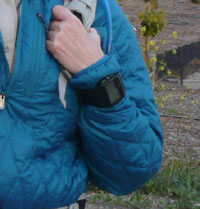
|
I thought I would become more familiar with
the digital compass. I was lost in the snow again this year
at Mt. San Jacinto State Park. My friend and I were prepared
this time with a working GPS unit. But, I thought I would use
the digital compass feature to try to navigate in the correct
direction. The compass was indicating south and I know
for a fact I was facing west, because I was facing the sun
set. I could not get an accurate reading. I even compared
it with a standard compass that my friend had. What bugs me
with the compass is that it can not be locked on. It turns
off after 30 seconds. I then have to press start to use the
compass again. I have calibrated the compass a few times by
following the instructions in the manual, so I do not know
why my readings are not accurate. I used it three times for
orientation purposes at Orchard Hills on a night hike. Two
out of the tree times it was correct. I determined this by
using the stars (Orion) for directional purposes.
I had the opportunity to use the watch in
a different time zone. It was simple to set up the other
time zone beforehand and then switch the watch to the current
time zone I was in. The watch can be set for no more than two
time zones. I found this feature also handy for day light savings
time that occurred on March 14 th. Since the additional time
zone I set for the watch was an hour earlier, and that is what
I needed for daylight savings time; I just set the watch to
my other time zone instead of resetting the time.
I compared the barometric pressure to
local weather stations and NOAA (National Oceanic
and Atmospheric Administration). It was very close to
the recorded barometric pressure at these sites, it was only
off by .02 to .06 in Hg. But, the recorded referenced data
was not at my exact location, sometimes a few miles away. I
am happy with the accuracy of the barometric pressure reading
on the Timex WS4.
The watch became wet after I dropped it in
a puddle while hiking at Whiting Ranch. I was changing my layering
system and I had to take off the watch. And there it went into
the puddle. It worked perfectly fine after becoming wet. The
puddle was not very deep. It did not go over the tops of my
shoes.
On my night hike at Orchard Hills people were
asking me what time it was. It was dark out since the moon
did not rise yet at that point. I know the location of the
INDIGLO button from memory and I was able to easily locate
it and let them know what time it was. Plus the button is silver
so I can see it more easily than the black buttons in dim light.
It would be nice if the button had a dim glow at night. The
INDIGLO button is rounded and has a different texture than
the other buttons. So, it is easy for me to find it by touch.
I think the weather forecast function is more
of a novelty. I am finding that it is not very accurate. The
watch can be calibrated to reflect the correct weather, but
I find that I seldom calibrate the watch this way. I generally
know the weather forecast before heading out on my trip, and
sometimes that is not very accurate. I just tend to look at
the sky to have an accurate weather forecast.
I wish there was a clip to hang the WS4 on
my backpack instead of strapping it to the pack. I like to
know the temperature when I am hiking and when I wear the watch
on my wrist, the temperature is inaccurate because it is also
getting heat from my body. When it is not worn on my arm it
is mostly accurate and may at time only be off a degree or
two.
I am still determining if this is the watch
for me. I am getting more into tracking additional data with
my GPS watch. I will continue to use this on trips that I do
not need my GPS watch functionality.
Things That Rock:
- Easy to set up, works out of the box for
most functions.
- Large display
- Buttons are easy to press
- I was able to complete a few operations
without reading the manual
- Graphs of my trip for elevation and temperature
Things That Are So-So:
- Kind of big (I may actually like the size
in the field)
- I can not hear the alarm when I am sleeping
- Manual set of the altitude is not as intuitive
as the other settings
- As with many battery operated devices,
the performance is diminished in temperatures below freezing
Remarks
This concludes
my reporting on the Timex WS4. Thank you Timex and backpackgeartest.org
for providing me with the opportunity to test this product.
|




